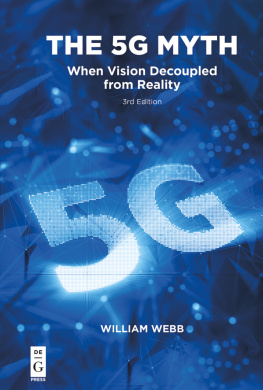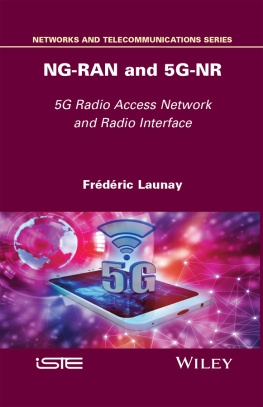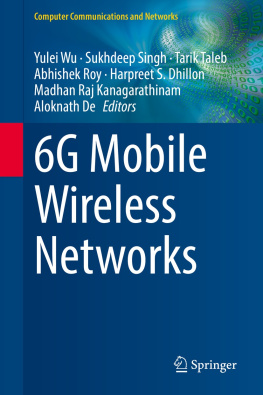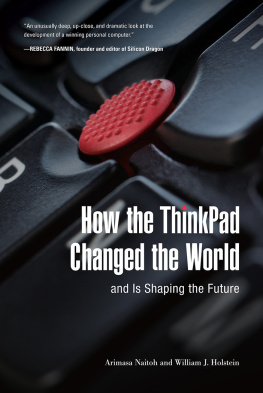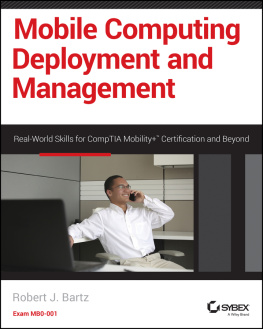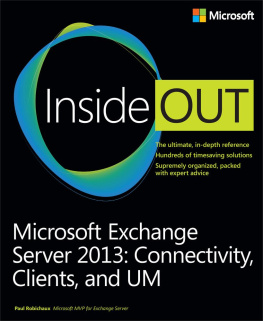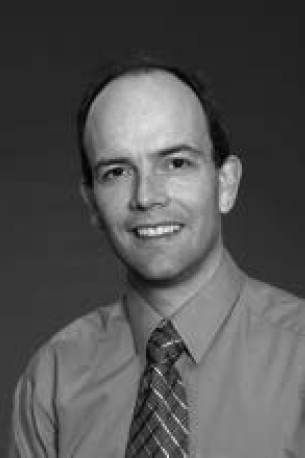Contents
Guide

William Webb
The 5G Myth
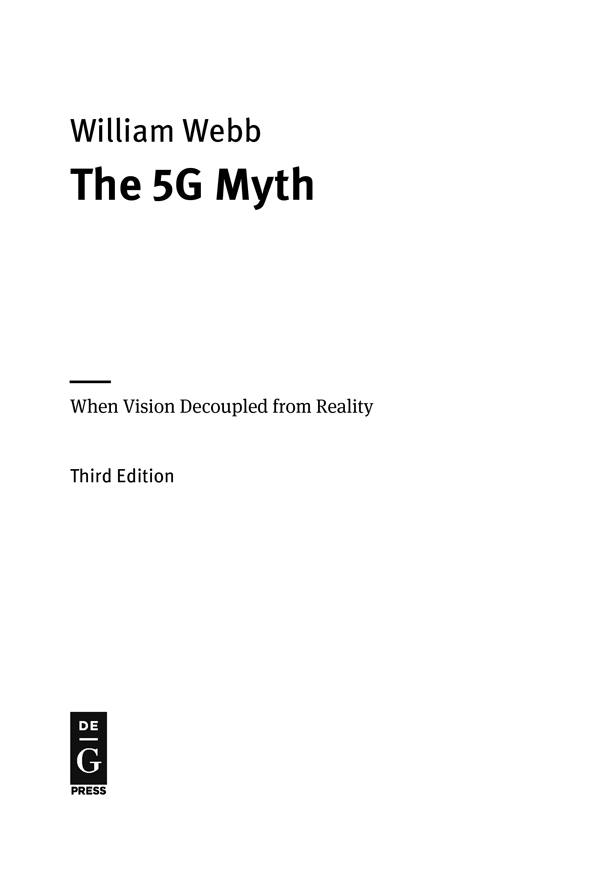
ISBN 978-1-5474-1728-5
e-ISBN (PDF) 978-1-5474-0118-5
e-ISBN (EPUB) 978-1-5474-0120-8
Library of Congress Control Number: 2018956918
Bibliographic information published by the Deutsche Nationalbibliothek
The Deutsche Nationalbibliothek lists this publication in the Deutsche Nationalbibliografie;
detailed bibliographic data are available on the Internet at http://dnb.dnb.de.
2019 William Webb
Published by Walter de Gruyter Inc., Boston/Berlin
Cover Image: Vertigo3d / iStock / Getty Images Plus
www.degruyter.com
myth
n .
A belief or set of beliefs, often unproven or false, that have accrued around a person, phenomenon, or institution .
(Farlex, The Free Dictionary , https://www.thefreedictionary.com/myth)
About De|G PRESS
Five Stars as a Rule
De|G PRESS, the startup born out of one of the worlds most venerable publishers, De Gruyter, promises to bring you an unbiased, valuable, and meticulously edited work on important topics in the fields of business, information technology, computing, engineering, and mathematics. By selecting the finest authors to present, without bias, information necessary for their chosen topic for professionals , in the depth you would hope for, we wish to satisfy your needs and earn our five-star ranking.
In keeping with these principles, the books you read from De|G PRESS will be practical, efficient and, if we have done our job right, yield many returns on their price.
We invite businesses to order our books in bulk in print or electronic form as a best solution to meeting the learning needs of your organization, or parts of your organization, in a most cost-effective manner.
There is no better way to learn about a subject in depth than from a book that is efficient, clear, well organized, and information rich. A great book can provide life-changing knowledge. We hope that with De|G PRESS books you will find that to be the case.
Acknowledgments
Because the ideas in this book are unconventional, I have sought critical reviews from a range of colleagues. A series of debates arranged through Cambridge Wireless were most helpful, and I would like to thank the panelists for their insightsnamely, Joe Butler, Moray Rumney, Paul Ceely, Howard Benn, Richard Feasey, Tony Lavender, and Stephen Howard, as well as the chief executive officer of Cambridge Wireless, Robert Driver, for arranging the debates. Others who have kindly reviewed material include Steve Methley, Brian Williamson, Dennis Roberson, and Rob Kenny. Of course, this in no way implies that they agree with everything written here; indeed, sometimes it is quite the converse.
I have been informed and inspired by a wide range of colleagues who have presented at conferences or worked with me on the many projects that helped build the insight presented here. Thanks to all.
And finally, to my family for putting up with my introspection as I pondered the wisdom of writing this book.
About the Author
William Webb is the director at Webb Search Consulting, a company specializing in matters associated with wireless technology and regulation. He is also the chief operating officer of Weightless SIG, the standards body that is developing a new global machine-to-machine (M2M) technology. During 20142015 he was president of the Institute of Engineering and Technology (IET), which is Europes largest professional engineering body.
In 2011, Mr. Webb was one of the founding directors of Neul, a company developing M2M technologies and networks which was subsequently sold to Huawei in 2014. He has also been a director at the UKs Office of Communications (Ofcom), where he managed a team providing technical advice and performing research across all areas of Ofcoms regulatory remit. During his work with Ofcom, he led some of the major reviews, including the Spectrum Framework Review , the development of spectrum usage rights, and cognitive or white space policy. William has also worked for a range of communications consultancies in the United Kingdom in the fields of hardware design, computer simulation, propagation modeling, spectrum management, and strategy development and spent three years providing strategic management across Motorolas entire communications portfolio in Chicago.
William has published 16 books and over 100 papers and holds 18 patents. He is a visiting professor at Surrey and Southampton Universities; an adjunct professor at Trinity College Dublin; and a fellow of the Royal Academy of Engineering, the Institute of Electrical and Electronics Engineers (IEEE), and the IET. In 2015 he was awarded the honorary degree of doctor of science by Southampton University in recognition of his work on wireless technologies and honorary doctor of technology by Anglia Ruskin University in recognition of his contribution to the engineering profession. His biography is included in multiple Whos Who publications around the world. William has a first-class honors degree in electronics, a PhD, and an MBA. He can be contacted at .
- W. Webb, Our Digital Future (Amazon, 2017).
- M. Cave and W. Webb, Spectrum Management: Using the Airwaves for Maximum Social and Economic Benefit (Cambridge, UK: Cambridge University Press, 2015).
- W Webb, Dynamic White Space Spectrum Access (Cambridge, UK: Webb Search Limited, September 2013).
- W. Webb, Understanding Weightless (Cambridge, UK: Cambridge University Press, March 2012).
- W. Webb, Being Mobile: Future Wireless Technologies and Applications (Cambridge, UK: Cambridge University Press, 2010).
- M. Cave, C. Doyle, and W. T. Webb, Essentials of Modern Spectrum Management (Cambridge, UK: Cambridge University Press, 2007).
- W. T. Webb, Wireless Communications: The Future (Chichester, UK: Wiley, 2007).
- L. Hanzo, K. Ng, T. Keller, and W. Webb, Quadrature Amplitude Modulation , 2nd ed. (Chichester, UK: Wiley, 2004).
- W. T. Webb, The Future of Wireless Communications (Norwood, MA: Artech House, 2001).
Further books and a full list of publications are available at www.webbsearch.co.uk.
Preface
The first edition of this book was published in November 2016a time when the anticipation and expectation from 5G was enormous. The term 5G permeated almost every major announcement from the wireless telecommunications industry; governments, politicians, and international bodies all wanted to be associated with the future vision it promised. The book attempted to bring some pragmatic reality to a world where hype and optimistic thinking appeared to predominate.
Nearly two years have passed since thena long time in the development of a new cellular technology, especially one that in 2016 was forecast to be deployed by 2018. More evidence has come to light regarding 5G, and I have engaged in much debate about my thinking that has helped further develop my arguments. As a result, it seems timely to provide an update to the book, albeit a relatively minor one. This third edition provides a new introduction to 5G in , and the book has been made more readable for a broader audience without sacrificing any of the content.
Between the first and this edition, very little has actually happened, much as I predicted. Although 5G specifications have progressed and some elements are now finalized, much remains to be done. Trials and test-beds apparently continue (although there is very little information as to what they have discovered), and the term 5G still pervades many announcements. No new uses or services have emerged which might change the average revenue per users (ARPUs) or user requirements, and no insights are yet available from efforts to use mmWave solutions to deliver fixed-wireless access. However, one important change has occurredskepticism in 5G has grown. In November 2017 Vodafones chief technology officer (CTO) stated that 5G was overhyped and the key benefit was efficiency gains,

